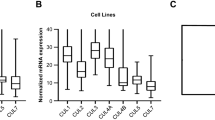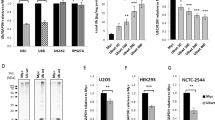Abstract
The ubiquitin–proteasome system (UPS) promotes the destruction of target proteins by attaching to them a ubiquitin chain that is recognized by the 26S proteasome1. The UPS influences most cellular processes, and its targets include transcriptional activators that are primary determinants of gene expression. Emerging evidence indicates that non-proteolytic functions of the UPS might stimulate transcriptional activity2,3. Here we show that the proteolysis of some transcriptional activators by the UPS can stimulate their function. We focused on the role of UPS-dependent proteolysis in the function of inducible transcriptional activators in yeast, and found that inhibition of the proteasome4 reduced transcription of the targets of the activators Gcn4, Gal4 and Ino2/4. In addition, mutations in SCFCdc4, the ubiquitin ligase for Gcn4 (ref. 5), or mutations in ubiquitin that prevent degradation6, also impaired the transcription of Gcn4 targets. These transcriptional defects were manifested despite the enhanced abundance of Gcn4 on cognate promoters. Proteasome inhibition also decreased the association of RNA polymerase II with Gcn4, Gal4 and Ino2/4 targets, as did mutations in SCFCdc4 for Gcn4 targets. Expression of a stable phospho-site mutant of Gcn4 (ref. 7) or disruption of the kinases that target Gcn4 for turnover5,7 alleviated the sensitivity of Gcn4 activity to defects in the UPS.
This is a preview of subscription content, access via your institution
Access options
Subscribe to this journal
Receive 51 print issues and online access
$199.00 per year
only $3.90 per issue
Buy this article
- Purchase on Springer Link
- Instant access to full article PDF
Prices may be subject to local taxes which are calculated during checkout



Similar content being viewed by others
References
Pickart, C. M. Back to the future with ubiquitin. Cell 116, 181–190 (2004)
Muratani, M. & Tansey, W. P. How the ubiquitin–proteasome system controls transcription. Nature Rev. Mol. Cell Biol. 4, 192–201 (2003)
Lipford, J. R. & Deshaies, R. J. Diverse roles for ubiquitin-dependent proteolysis in transcriptional activation. Nature Cell Biol. 5, 845–850 (2003)
Lee, D. H. & Goldberg, A. L. Proteasome inhibitors: valuable new tools for cell biologists. Trends Cell Biol. 8, 397–403 (1998)
Meimoun, A. et al. Degradation of the transcription factor Gcn4 requires the kinase Pho85 and the SCF(CDC4) ubiquitin-ligase complex. Mol. Biol. Cell 11, 915–927 (2000)
Finley, D. et al. Inhibition of proteolysis and cell-cycle progression in a multiubiquitination-deficient yeast mutant. Mol. Cell. Biol. 14, 5501–5509 (1994)
Chi, Y. et al. Negative regulation of Gcn4 and Msn2 transcription factors by Srb10 cyclin-dependent kinase. Genes Dev. 15, 1078–1092 (2001)
Adams, J. & Kauffman, M. Development of the proteasome inhibitor Velcade (bortezomib). Cancer Invest. 22, 304–311 (2004)
Mitsiades, N. et al. Molecular sequelae of proteasome inhibition in human multiple myeloma cells. Proc. Natl Acad. Sci. USA 99, 14374–14379 (2002)
Fleming, J. A. et al. Complementary whole-genome technologies reveal the cellular response to proteasome inhibition by PS-341. Proc. Natl Acad. Sci. USA 99, 1461–1466 (2002)
Hinnebusch, A. G. & Natarajan, K. Gcn4p, a master regulator of gene expression, is controlled at multiple levels by diverse signals of starvation and stress. Eukaryot. Cell 1, 22–32 (2002)
Kornitzer, D., Raboy, B., Kulka, R. G. & Fink, G. R. Regulated degradation of the transcription factor GCN4. EMBO J. 13, 6021–6030 (1994)
Albrecht, G., Mosch, H. U., Hoffmann, B., Reusser, U. & Braus, G. H. Monitoring the Gcn4 protein-mediated response in the yeast Saccharomyces cerevisiae. J. Biol. Chem. 273, 12696–12702 (1998)
Hilt, W., Enenkel, C., Gruhler, A., Singer, T. & Wolf, D. H. The PRE4 gene codes for a subunit of the yeast proteasome necessary for peptidylglutamyl-peptide-hydrolyzing activity. Mutations link the proteasome to stress- and ubiquitin-dependent proteolysis. J. Biol. Chem. 268, 3479–3486 (1993)
Salghetti, S. E., Caudy, A. A., Chenoweth, J. G. & Tansey, W. P. Regulation of transcriptional activation domain function by ubiquitin. Science 293, 1651–1653 (2001)
Kim, S., Herbst, A., Tworkowski, K., Salghetti, S. & Tansey, W. Skp2 regulates Myc protein stability and activity. Mol. Cell 11, 1177–1188 (2003)
von der Lehr, N. et al. The F-Box protein Skp2 participates in c-Myc proteosomal degradation and acts as a cofactor for c-Myc-regulated transcription. Mol. Cell 11, 1177–1188 (2003)
Aparicio, O., Geisberg, J. & Struhl, K. in Current Protocols in Molecular Biology (eds Ausubel, F. M. et al.) 21.3.1–21.3.12 (Wiley, New York, 2004)
Stitzel, M. L., Durso, R. & Reese, J. C. The proteasome regulates the UV-induced activation of the AP-1-like transcription factor Gcn4. Genes Dev. 15, 128–133 (2001)
Reid, G. et al. Cyclic, proteasome-mediated turnover of unliganded and liganded ERα on responsive promoters is an integral feature of estrogen signalling. Mol. Cell 11, 695–707 (2003)
Gonzalez, F., Delahodde, A., Kodadek, T. & Johnston, S. A. Recruitment of a 19S proteasome subcomplex to an activated promoter. Science 296, 548–550 (2002)
Morris, M. C. et al. Cks1-dependent proteasome recruitment and activation of CDC20 transcription in budding yeast. Nature 423, 1009–1013 (2003)
Verma, R. et al. Deubiquitination and degradation of proteins by the 26S proteasome requires the Rpn11 metalloprotease motif. Science 298, 611–615 (2002)
Muratani, M., Kung, C., Shokat, K. M. & Tansey, W. P. The F box protein Dsg1/Mdm30 is a transcriptional coactivator that stimulates Gal4 turnover and cotranscriptional mRNA processing. Cell 120, 887–899 (2005)
Hirst, M., Kobor, M. S., Kuriakose, N., Greenblatt, J. & Sadowski, I. GAL4 is regulated by the RNA polymerase II holoenzyme-associated cyclin-dependent protein kinase SRB10/CDK8. Mol. Cell 3, 673–678 (1999)
Guthrie, C. & Fink, G. R. Guide to Yeast Genetics and Molecular Biology (Academic, San Diego, 1991)
Drysdale, C. M. et al. The transcriptional activator GCN4 contains multiple activation domains that are critically dependent on hydrophobic amino acids. Mol. Cell. Biol. 15, 1220–1233 (1995)
Acknowledgements
We thank D. Finley, D. H. Wolf, R. Young, A. Hinnebusch, J. Shaw, B. Westermann, J. Nunnari and G. Braus for gifts of strains and reagents; B. Tansey for communicating results before publication; and J. Shaw, B. Westermann, J. Nunnari, S. Sadis, A. Ansari and the members of the Deshaies laboratory for comments and criticism. This work was supported in part by an NIH Research Project Grant to R.J.D. R.J.D. is an Investigator of the Howard Hughes Medical Institute. J.R.L. was supported by an NIH National Research Service Award and a Caltech-Amgen Postdoctoral Fellowship.
Author information
Authors and Affiliations
Corresponding author
Ethics declarations
Competing interests
Reprints and permissions information is available at npg.nature.com/reprintsandpermissions. The authors declare no competing financial interests.
Supplementary information
Supplementary Notes
This file contains Supplementary Table 1 and 2, Supplementary Figure Legends, Supplementary Methods, and Supplementary Discussion. This file also contains details of NIH support. (DOC 166 kb)
Supplementary Figure 1
Proteasome inhibition represses the transcription of many Gcn4 targets and of INO1, a target of the transcriptional activators, Ino2 and Ino4. (PDF 36 kb)
Supplementary Figure 2
Gal4-TAP functions similarly to wild-type Gal4. pdr5δ, GAL4-TAP strains were treated as in Fig. 1b. (PDF 29 kb)
Supplementary Figure 3
Proteasome inhibition does not affect the dynamic association of Gal80 with a Gal4 target. (PDF 29 kb)
Supplementary Figure 4
Gcn4 is required for the association of RNA polymerase II (polII) with HIS4. (PDF 16 kb)
Rights and permissions
About this article
Cite this article
Lipford, J., Smith, G., Chi, Y. et al. A putative stimulatory role for activator turnover in gene expression. Nature 438, 113–116 (2005). https://doi.org/10.1038/nature04098
Received:
Accepted:
Issue Date:
DOI: https://doi.org/10.1038/nature04098
This article is cited by
-
The neglected part of early embryonic development: maternal protein degradation
Cellular and Molecular Life Sciences (2020)
-
Translational and post-translational regulation of mouse cation transport regulator homolog 1
Scientific Reports (2016)
-
Spt6 levels are modulated by PAAF1 and proteasome to regulate the HIV-1 LTR
Retrovirology (2012)
-
Transcriptional activators and activation mechanisms
Protein & Cell (2011)
-
Gal4 turnover and transcription activation
Nature (2009)
Comments
By submitting a comment you agree to abide by our Terms and Community Guidelines. If you find something abusive or that does not comply with our terms or guidelines please flag it as inappropriate.



